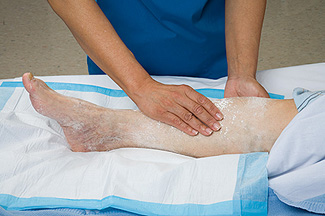Purpose
- Promote supplementing the action of muscle contraction by venous return from the legs
- Prevent deep vein thrombosis in the immobile client
Assessment
- Identify clients at high risk for deep vein thrombosis (e.g., long-term bed rest, cardiovascular disease).
- Obtain physician order.
Equipment
- Stockings (available in knee-high and thigh-high lengths)
- Measuring tape to assess correct size of stocking
- Baby powder or talcum powder
- Towel or waterproof pad if applying powder
Procedure
-
Position client in supine position for a half-hour before applying stockings.
Rationale: Veins should not be distended with blood when stockings are applied.
-
Provide for the client's privacy and explain the purpose of the antiembolic stockings.
Rationale: Adequate knowledge increases client's participation and compliance.
-
Measure for proper fit before first application. Measure length (heel to groin) and width (calf and thigh) and compare to manufacturer's printed material to ensure proper fit (Fig. 1).
Rationale: Stockings that are too tight can lead to venous occlusion, and stockings that are too loose do not promote venous return. Estimating size rather than measuring often results in errors.

Fig. 1: Measure to ensure proper fit.
-
Make sure legs are dry or apply a light dusting of powder (Fig. 2).
Rationale: Dry legs ease application.

Fig. 2: Powder skin lightly unless contraindicated.
-
Turn the stocking inside out, tucking the foot inside (Fig. 3).
Rationale: Inside-out method allows for easier application of stocking because stocking is not bunched up.

Fig. 3: Turn stocking inside out, tucking heel inside.
-
Ease foot section over the client's toe and heel, adjusting as necessary for proper smooth fit (Fig. 4).
Rationale: Minimize wrinkles that impede circulation.

Fig. 4: Stretch stocking over knee. Smooth to remove wrinkles.
-
Gently pull the stocking over the leg, removing all wrinkles (Fig. 5 and 6).
Rationale: Irregularities in fit may cause pressure areas.

Fig. 5: Pull stocking over leg.

Fig. 6: Stretch stocking over knee. Smooth to remove wrinkles.
-
Assess toes for circulation and warmth. Check area at top of stocking for binding (Fig. 7).
Rationale: Constriction and rolling down of stockings during wear are the result of poor fit and can impede circulation and cause thrombosis.

Fig. 7: Assess for skin color, temperature, sensation, swelling, and
the ability to move.
-
Antiembolic stockings should be removed at least twice daily (Fig. 8).
Rationale: Wash skin and assess for edema or irritation.

Fig. 8: Grasp stockings and smoothly pull off inside out.
| Sample Documentation | ||
| 09/05/10 | 0900 |
P: Impaired peripheral circulation secondary to bedrest. I: Measured for antiembolic stockings, medium hose applied, taught regarding importance of stocking in preventing blood stasis and clots. E: Continue to monitor peripheral circulation and remove stocking every shift to inspect skin for areas of breakdown. S. Roberts, RN |
Lifespan Considerations
Infant/Child- Antiembolic stockings are infrequently used in children.
- Proper fitting of antiembolic stockings is difficult in the obese client and requires special attention for areas of constriction and binding.
- Elastic (Ace) bandages may be an alternative to provide antiembolic protection in clients for whom
Home Care Modifications
- Instruct clients to apply stockings before getting out of bed.
- Instruct clients to remove stockings regularly for skin inspection and cleansing.
- Be sure clients understand that commercial support stockings are not a substitute for medical antiembolic stockings.
Collaboration and Delegation
- Frequently, unlicensed assistive personnel remove and replace antiembolic stockings while performing hygiene care. Ensure that unlicensed assistive personnel do these procedures at least twice every day and that they report any signs of pressure or breakdown to you.